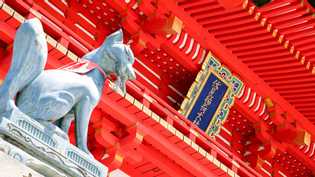お稲荷さん その2 - The Origin of O-Inari-San
The Myogonji, a Zen Temple in Toyokawa, Aichi Prefecture, has the Toyokawa Inari. This shrine is not the oldest in Japan, but it is one of the most famous. One of its priests was returning from China when he had a vision. In this vision, he saw Dagini, an Indian goddess, riding on a fox. He was so impressed that he carved out a figure of Dagini in wood. This statue was handed down to his disciples.
愛知県豊川市にある禅寺・妙厳寺には豊川稲荷という神社があります。これは、日本最古の神社というわけではありませんが、最も知られた神社の一つです。豊川稲荷のある神官が、中国からの帰国の途、きつねに乗ったインドの女神ダギニの幻影を見ました。たいへん衝撃を受けた神官は、木彫りのダギニ像を作りました。その像は弟子たちによって受け継がれたということです。
In 1441, another priest took the statue to Mikawa Province, and built the Myogonji Temple. In the temple, he built a shrine to put the statue of Dagini in. This shrine immediately became the object of popular worship. As she was shown riding a fox, the shrine came to be called, “Inari”. This led to the popularity of the Fushimi Inari Shrine. This popularity has never diminished.
1441年、別の神官が三河の国に妙厳寺を建立し、その中にダギニ象を奉納する神社を建てたところ、たちまち人々がそこを訪れ手を合わせるようになりました。ダギニがきつねに乗っていたことから、この神社は稲荷と呼ばれ、やがて、伏見稲荷にも民衆の支持が集まるようになりました。以来、人々の稲荷神社への信仰は決して衰えることはありません。
One more reason it became so popular among the people was that a high official of the Tokugawa Shogunate, worshipped the Toyokawa Inari, and he had a small shrine built in his house to continue his worship. He rose rapidly in the Shogunate, and everyone thought it came from his true dedication to the god. After his success came, and his habit of worship became known, other samurai, and people wishing riches and advancement, came to worship the Toyokawa Inari. Sounds like human nature to me. If anything has a beneficial point for the people to follow, they will do so.
稲荷神社が民衆の間で信仰されるようになったもう一つの理由に、徳川幕府の要職にあった一人の人物が豊川稲荷を参拝し、自らの邸宅に小さな社を建て崇拝し続けたことがあります。彼は幕府の中でまたたくまに出世を遂げましたが、だれもがそれを彼の敬虔な信仰のせいであると考えました。彼が名を上げ、その崇拝ぶりが人々の知るところとなると、富と栄達を願う民衆や武士たちも豊川稲荷を訪れるようになりました。これも人間の性なのでしょう。人はだれでも、自分の得になるとわかるとそれを追い求めるものです。
Besides that, the Japanese people have a cheerful point of view and love the fact that they can have something to respect, and call upon in time of trouble, even though they don’t really believe in it until trouble strikes. This is true in all countries with any religion. Even Christianity has it. We often call such people “Foxhole Christians.”
そのうえ、日本の人々は楽観的で、敬う対象を持つことを好み、困ったことがあるとそれまでは神を信じていなかったような人でも救いを求めるのです。しかし、これは日本に限ったことではなく、すべての国のいかなる宗教にも見られることなのです。キリスト教も例外ではなく、こうした人たちを、“たこつぼクリスチャン”と呼びます。
